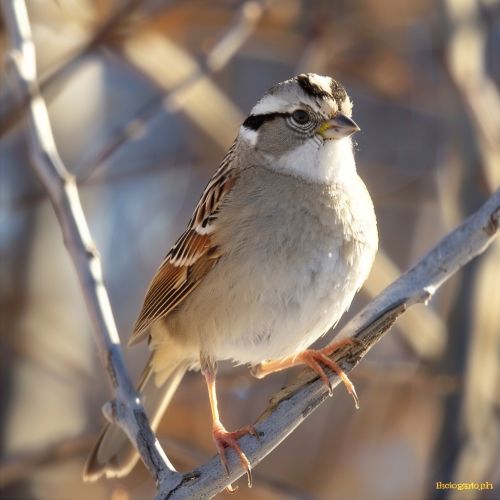White-crowned Sparrow: Difference between revisions
(Created page with "== Description == The White-crowned Sparrow (''Zonotrichia leucophrys'') is a medium-sized sparrow native to North America. It is easily recognizable by its striking black and white head pattern, which gives it its name. This species is known for its distinctive song, which varies regionally and is often used in studies of bird song and communication. == Taxonomy and Classification == The White-crowned Sparrow belongs to the family Passerellidae, which include...") |
No edit summary |
||
| Line 17: | Line 17: | ||
Adult White-crowned Sparrows measure approximately 17-19 cm in length, with a wingspan of 23-25 cm. They weigh between 25-30 grams. The most distinctive feature is the black and white striped crown. The back is brown with streaks, while the underparts are gray. Juveniles have a more subdued brown and tan head pattern. | Adult White-crowned Sparrows measure approximately 17-19 cm in length, with a wingspan of 23-25 cm. They weigh between 25-30 grams. The most distinctive feature is the black and white striped crown. The back is brown with streaks, while the underparts are gray. Juveniles have a more subdued brown and tan head pattern. | ||
[[Image:Detail-91775.jpg|thumb|center|White-crowned Sparrow perched on a branch.|class=only_on_mobile]] | |||
[[Image:Detail-91776.jpg|thumb|center|White-crowned Sparrow perched on a branch.|class=only_on_desktop]] | |||
== Distribution and Habitat == | == Distribution and Habitat == | ||
Latest revision as of 17:21, 19 June 2024
Description
The White-crowned Sparrow (Zonotrichia leucophrys) is a medium-sized sparrow native to North America. It is easily recognizable by its striking black and white head pattern, which gives it its name. This species is known for its distinctive song, which varies regionally and is often used in studies of bird song and communication.
Taxonomy and Classification
The White-crowned Sparrow belongs to the family Passerellidae, which includes New World sparrows. The genus Zonotrichia comprises five species, with the White-crowned Sparrow being one of the most studied. There are five recognized subspecies of the White-crowned Sparrow, each with slight variations in plumage and song:
- Zonotrichia leucophrys leucophrys
- Zonotrichia leucophrys gambelii
- Zonotrichia leucophrys nuttalli
- Zonotrichia leucophrys pugetensis
- Zonotrichia leucophrys oriantha
Morphology
Adult White-crowned Sparrows measure approximately 17-19 cm in length, with a wingspan of 23-25 cm. They weigh between 25-30 grams. The most distinctive feature is the black and white striped crown. The back is brown with streaks, while the underparts are gray. Juveniles have a more subdued brown and tan head pattern.


Distribution and Habitat
White-crowned Sparrows are found across North America, from Alaska and Canada to the northern United States. They inhabit a variety of environments, including tundra, shrublands, and forests. During the breeding season, they prefer open areas with dense shrubbery, while in winter, they can be found in more diverse habitats, including gardens and parks.
Behavior and Ecology
Feeding
White-crowned Sparrows are primarily granivorous, feeding on seeds and grains. However, they also consume insects, especially during the breeding season when protein is essential for chick development. They forage on the ground, often scratching the soil with their feet to uncover food.
Breeding
Breeding occurs from May to August, with peak activity in June. Nests are typically built close to the ground in dense vegetation. The female lays 3-5 eggs, which she incubates for about 12 days. Both parents participate in feeding the chicks, which fledge approximately 9-11 days after hatching.
Migration
White-crowned Sparrows are migratory, with northern populations traveling to the southern United States and Mexico for the winter. Migration routes and timing vary among the subspecies. For example, Z. l. gambelii migrates from Alaska to the southwestern United States, while Z. l. nuttalli is largely resident in California.
Vocalizations
The song of the White-crowned Sparrow is a series of clear whistles followed by trills and buzzes. Each subspecies has a distinct song pattern, which has been extensively studied in the context of avian communication and song learning. These studies have provided insights into the mechanisms of vocal learning and the role of environmental factors in shaping song variation.
Conservation Status
The White-crowned Sparrow is currently listed as a species of Least Concern by the International Union for Conservation of Nature (IUCN). However, habitat loss and climate change pose potential threats to some populations. Conservation efforts focus on habitat preservation and monitoring population trends.
Research and Studies
White-crowned Sparrows have been the subject of numerous scientific studies, particularly in the fields of behavioral ecology, neurobiology, and evolutionary biology. Research on their song learning has contributed to our understanding of neural plasticity and the genetic basis of behavior. Additionally, studies on their migratory patterns have provided valuable data on the effects of climate change on bird migration.
